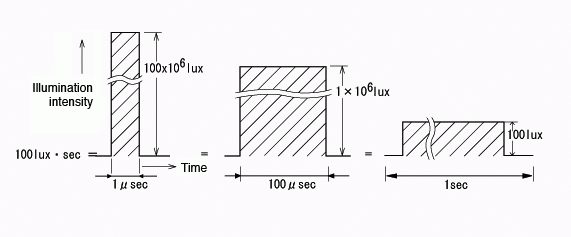Stroboscopic intensity
Please explain the brightness of a stroboscope.
Our company uses the input to the xenon flash tube incorporated into the stroboscope to determine the intensity of the stroboscopic illumination. The input to the xenon flash tube depends on the stroboscope model and flashing frequency. Our catalogs provide information on flashlamp input and maximum continuous input for your reference.
The following simple formula expresses flashlamp input:
P = (1/2)CV2
P: Flashlamp input (joule or J)
C: Electrostatic capacitance of capacitor (farad or F)
V: Charge voltage (volt or V)
When C = 1 µF (10-6 F) and V = 1000 V (V2= 106), the flashlamp input is as follows: P = 1/2 x 10-6 x 106 = 0.5 (joules or J).
For continuous and repeated flashing of the flashlamp for a certain duration (rather than single flashes), we can calculate maximum continuous input by multiplying P (= 1/2CV2) above by strobe frequency (Hz). For instance, if the flashlamp flashes repeatedly at 100 Hz, the maximum continuous input is as follows: P = 0.5 x 100 = 50 (watts or W).
Is there a way to express brightness more objectively than using the "joule" or "watt" specification of flashlamp input?

A unit called lux second (lx·s) is suitable for expressing the brightness of the momentary light emitted by a stroboscope. "Lx·s" is a product of "lx," a unit used to express the intensity of stationary light and "s," a unit of time. For example, "100 lx·s" means that if the stroboscope's flash duration (extremely brief duration of each strobe light emission) is 1 µs (1/1,000,000 of a second), the peak illumination intensity is 100 x 106 lx.
What is the relationship between flashlamp input and brightness?
The relationship between flashlamp input and brightness is said to be approximately 30 lm·s per 1 J (W·S), based on the use of lumen sec (lm·s), a more precise unit of brightness. This value translates to an illumination intensity of approximately 2.39 lx·s at a distance of one meter from the light source.*
In the case of Sugawara's PS-240D stroboscope, the illumination intensity at one meter from the light source is about 24 lx·s, since the flashlamp input in the A range is about 10 J (W·S).
However, this value indicates the illumination intensity per unit solid angle from the bare light source. We need to distinguish this intensity from the intensity of light reflected and converged by mirrors and lenses.
* An illumination intensity of 30 lm·s expresses omnidirectional light intensity (luminous flux x time). Since "omnidirectional" means 4πsr (sr: steradian), the light intensity per 1 sr is approximately 2.39 lm·s (30 lm·s ÷ 4π). Thus, an illumination intensity of approximately 2.39 lm·s at a distance of one meter from the light source is approximately 2.39 lx·s.